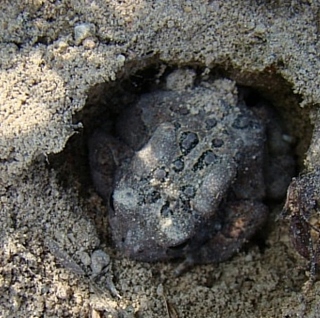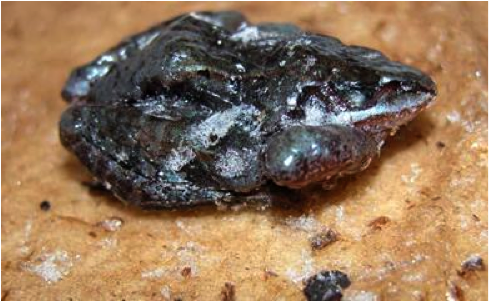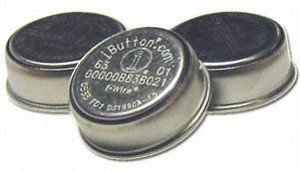Thomas Hastings, Scientific Research Specialist, University of Maine

Although this is an American toad (Anaxyrus americanus), the tucked position of the animal and the shape of the hibernacula closely resemble what was seen with the eight wood frogs in our study site. Photo credit: David LeGros.
The ability of wood frogs (Lithobates sylvaticus) to freeze during the winter is impressive. The rapid synthesis of glucose as a cryoprotectant decreases the damages resulting from intracellular ice formation. Water is also moved out of organs to reduce the severity of ice formation within the body (Costanzo et al., 2013). Wood frogs, unlike other amphibians, hibernate at the soil surface and do not avoid freezing temperatures as a winter survival strategy. Therefore, to tolerate winter conditions in a state such as Maine, these frogs need to choose wisely where they spend the winter. Hibernacula with damp soils is important for preventing dehydration, yet mud and soils with standing water should be avoided to reduce the risk of direct contact with ice (Licht, 1991; Churchill and Storey, 1993). Leaf litter also prevents snow and ice from accumulating directly on top of hibernating frogs. Hibernacula insulation and temperature stability can be promoted by leaf litter and greater snow depths. Freeze tolerance is more possible when insulating features provide protection from the coldest temperatures throughout the season (Pauli et al., 2013).

A frozen wood frog in the tucked position.
Physiological adaptations and hibernal habitat selection allow wood frogs to survive winter conditions. However, terrestrially hibernating animals that rely on environmental conditions such as snow fall are threatened by climate change. Decreased snow depth can reduce insulation and result in colder temperatures within wood frog hibernacula. Such conditions could possibly result in winter mortality (Pauli et al., 2013).
As part of an on-going study of wood frog movement and habitat selection in an urbanizing environment, we radio-tracked eight adult wood frogs to their hibernacula. Knowing the exact location of each individual, we are able to evaluate hibernacula characteristics, microclimate, winter survival rates, and movement of wood frogs toward vernal pools upon emergence. This information will allow us to better understand how urbanizing environments (neighborhoods, fields, and roads) influence wood frog hibernal habitat selection and survival. Following the methods of Groff et al. (2016), to study the microclimate of each hibernaculum, two iButtons (temperature loggers) were carefully positioned. One iButton was placed in the ground near the frog and the second was placed 2 m above each frog in a tree. Placement of the iButtons will detect differences in temperature between each frog’s hibernaculum and the surrounding air. Temperature differences and measured snow depth can indicate how insulated the eight wood frogs are in the urbanizing environment. To study winter survival and movement toward vernal pools, enclosures were constructed around each hibernating wood frog using the enclosure design of Groff et al. (2016). Upon wood frog emergence in the spring, enclosures will capture each individual, allowing us to estimate survival rates. Wood frogs will be collected from enclosures, fitted with a radio-transmitter, and tracked toward breeding locations.
Urbanizing environments present obvious threats to wood frogs. Earlier in the study, wood frogs were killed as a result of lawn mower injuries and domestic cats. However, we do not know how urbanizing environments influence winter survival and movements toward vernal pools. The most notable observation is that all eight frogs selected hibernacula within the forested wetland patch that was used as the summer activity center. Studies in the past have found that wood frogs make long migration movements back toward breeding locations prior to entering hibernacula (Regosin et al., 2003; Groff et al., 2016). Although the frogs stayed in the forested wetland, the hibernal habitat selection did not seem unusual. All wood frogs were found in what appeared to be a self-excavated cavity in the soil surface. Hibernacula cavities were close to the size of the frog and ranged from 3 to 5 cm below the leaf litter. All frogs were found in the tucked position.
This study is unique because we have a vernal pool that seems to be challenging wood frogs in multiple ways. Wood frogs at this site needed to make extensive migration movements through a neighborhood, were restricted from moving back toward the vernal pool in the fall, and therefore selected hibernacula within a forested wetland patch. With that being said, the frogs seem to be surviving in the altered environment. But with the recent warm weather and snow melting, the wood frogs may be facing more challenges soon. Results from this study may be helpful in understanding how tolerant of change wood frogs really are.
References
Churchill, T. A., and K. B. Storey. 1993. Dehydration tolerance in wood frogs: a new perspective on development of amphibian freeze tolerance. American Journal of Physiology – Regulatory, Integrative and Comparative Physiology 265(6):1324-1332.
Costanzo, J. P., M. C. F. do Amaral, A. J. Rosendale, and R. E. Lee, JR. 2013. Hibernation physiology, freezing adaptation and extreme freeze tolerance in a northern population of the wood frog. The Journal of Experimental Biology 216:3461-3473.
Groff, L. A., A. J. K. Calhoun, and C. S. Loftin. 2016. Hibernal habitat selection by wood frogs (Lithobates sylvaticus) in a northern New England montane landscape. Journal of Herpetology 50(4):559-569.
Licht, L. E. 1991. Habitat selection of Rana pipiens and Rana sylvatica during exposure to warm and cold temperatures. The American Midland Naturalist 125(2):259-268.
Pauli, J. N., B. Zuckerberg, J. P. Whiteman, and W. Porter. 2013. The subnivium: a deteriorating seasonal refugium. Frontiers in Ecology and the Environment 11(5):260-267.
Regosin, J. V., B. S. Windmiller, and J. M. Reed. 2003. Terrestrial habitat use and winter densities of the wood frog (Rana sylvatica). Journal of Herpetology 37(2):390-394.


